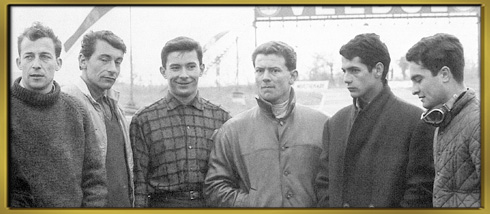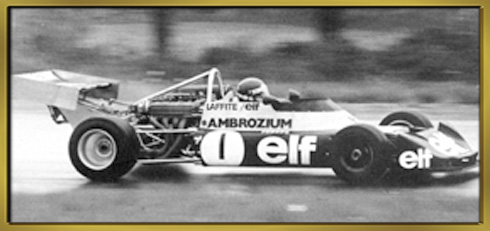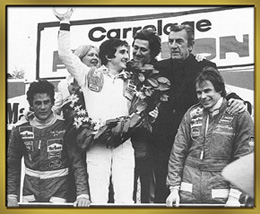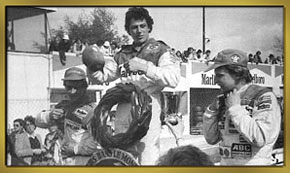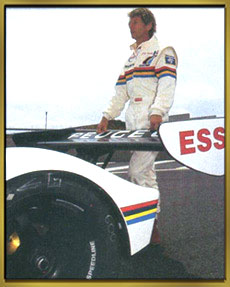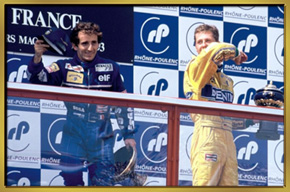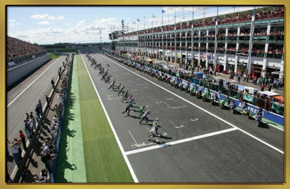
1961, first races The first car races on the Motor Stadium Jean Behra (former name of the Magny-Cours circuit) are held on sunday, May the 28th, 1961. These races, organised in the form of series, were called "1er Circuit de vitesse automobile" and re-edited each year at the same period (until 1977, there will be 16 of them in total).With over 10 000 entries and 4000 cars in the park, this event was a success with only three categories represented: "Tourisme améliorée", "Formule Junior" and "Grand Tourisme". For the anecdote, two British people both driving a Cooper-Austin will end at the head of the final ranking in « formule junior » during this afternoon. Maggs wins the race before Love, with an average speed of 113,420 km/h. The first "Circuit de vitesse moto" was organised on June 10 and 11, 1961, in the form of series as well.
Competitions take place on the circuit and the Martini production starts Today, we cannot talk about competitions without evoking Tico Martini's name. Arrived at the circuit's pilot school in 1963, his car manufacturer activities will have an important weight on the 40 years of competition that will take place on the circuit. In 1963 as well, we assist to the « Volant Shell » creation that rewards each year the best student of the pilot course . Jean-Pierre Jaussaud will be the first to win it. We are in 1964, events start to take shape on the Jean Behra circuit. During the 4th "Circuit de vitesse automobile", two future pillars of the French car sport will stand out : Guy Ligier and Henri Pescarolo. The first one will end at the second place in the GT and Sport category driving a Porsche 904, regarding the second one, he will win the "Coupe des Provinces de France". This is in 1967 that the Martini adventure will really start. Weary with the bad performances of the cars used by the school, he decides to build his own competition car. It will be called MW1, M like Martini et W like Winfield (the name of the pilot school he is managing). Then, since 1970, MK4 cars (M like Martini, K like Knight, his school partners) are leaving from the workshop. It is the start of a huge production.
The success of the circuit is growing. In 1969 the 9th "Circuit de vitesse automobile" is held and with 25,000 spectators, the record of visitors is broken. Jean-Pierre Jaussaud wins in Formule 3, Jean-Pierre Jabouille ends second. Martini already has good results in Formule France category with a second place for Trollé. On May the 2nd, 1971, we inaugurate the new circuit ( 3.850 km long) with the 11th "Circuit de vitesse automobile". The winner of the day is Gérard Larousse who wins in Sport et Sport Prototype, however Martini is victorious in Formule 3 and Formule France. This year is also marked with the death of Jean Bernigaud, on December the 23rd.
After Jean Bernigaud Jean Bernigaud being dead, his wife Jacqueline helped with her children decidesto keep organising competitions on the circuit. In 1973, Max Mamers wins before Xavier Lapeyre in "Coupe Simca 2 litres" with a Grac. After 11 « Volants Shell », this distinction disappear in 1974 and is being replaced by the « Pilote Elf ». The concept remains the same,but the sponsor is changing. Yves Le Strat becomes the 1st Elf pilot. For the first time in 1975 the Jean Behra circuit welcomes the Formule 2 Championship and it is Jean-Pierre Jabouille who wins the race. Only one Martini is represented in F2, it is Jacques Lafitte' s MK 16. Left in pole position, he will only end the race in 7th position due to mechanic troubles. In 1976, during the 16th "Circuit de vitesse automobile", Didier Pironi wins in Formule Renault Europe but a very young pilot wins in national Formule Renault, we talk about Alain Prost. the "journal du centre" write an article called : « Alain Prost, vedette de demain ? » (Alain Prost, star of tomorrow?) He will also win in Formule Renault during the 15th "Critérium automobile".
Jean-Bernigaud Trophees In 1977, in homage to Jean-Bernigaud, the traditional "Circuit de vitesse" is renamed "Trophées Jean-Bernigaud", but the concept remains the same. This year, the represented categories are: the Formule Renault Europe Challenge, the French Production Championship, the national Formule Renault Championship, the British Leyland Trophee, the Renault Elf 5TS race, the Golf GTI race and the Trophée Alfasud race. Martini realises a good operation in the European Formule Renault Challenge . Alain Prost wins and Dany Snobeck ends 3rd, both driving a Martini MK 20E. Alain Ferté (22 years old) is elected 4th Elf pilot.
In the same time, Jean-Pierre Jabouille is the first French pilot to win in Formula 1 at the French Grand Prix organised in the Dijon-Prenois circuit. The 1980 year marks the 20th birthday of the circuit. To celebrate this, 7 French F1 pilots (J. Laffite, D. Pironi, R. Arnoux, J-P Jarrier, J-P Jabouille, A. Prostand P. Depailler) race on the circuit in R5 Alpine.
In the same time, Alain Prost keeps improving. He obtains in 1981 his first victory in the F1 Grand Prix , in front of his public, on the Dijon-Prenois circuit. We are back in Magny-Cours. The 1986 year marks a turning point because the Departement Council of Nièvre buies the circuit to the Bernigaud family having in mind to build a F1 track. The Jean Behra circuit will finally be pulled down in 1988 to leave the place to the new Nevers-Magny-Cours circuit ready to welcome the F1 Grand Prix..
1990, a new era starts … Things go fast. In 1990 FISA gives a 5 year lease to the company managing the Magny-Circuit (SAEPCNMC) to organise the French Grand Prix from 1991 à 1995. The first F1 GP on the new circuit is held on July 7th, 1991, after 6 straight years of organisation on the Paul-Ricard circuit. This event will gather more than 100,000 spectators who will see Nigel Mansell winning the race. Alain Prost will end second this year in front of his public and another French pilot will end 4th, it is Jean Alesi.
In 1992, the French Moto Grand Prix is organised only for this year in Magny-Cours. In 125 and 250 cm3, two Italiens pilots (Gianola and Reggiani) win the race and in the uppest category (500cm3) an American pilot, Wayne Rainey, is victorious. Prost will not drive in F1 during the 1992 season. This year, Nigel Mansell will win once again and the French pilot Erik Comas will end the race in 5th position driving a Ligier-Renault. The Grand Prix is organised in particular conditions because a carrier strike is blocking the main road axes on the French territory. For this anecdote, every racing Team finally arrive in time except one, Andrea Monda, amateur team that will stop the F1 competition at the end of this year. In 1993, it is the accolade, Alain Prost is the first French pilot to win the victory in F1 in Magny-Cours. He finishes the race in 1h 38min 35s juste before Damon Hill and Michael Schumacher.
1993 also marks the year when the Evin law is in effect, prohibiting advertising for tabacco and alcohol. Many people think it is the end of the French car sport, that highly depended in those financial supports. For the anecdote, the organisation is even obliged to take off the sticker with the brand on the champagne bottle before its opening on the podium! The 1994 year was the Michael Schumacher year. He is going to win in Magny-Cours, it will the first of its 8 victories at the French Grand Prix. He still has the record of number of victories on this GP (6 for Alain Prost, 4 for Juan Manuel Fangio and 2 for Nigel Mansell). This year will also be the one of his first title. In 1996, it is the Bristish Damon Hill who wins the French F1 Grand Prix but for the first time since 1993, a French pilot climbs on theMagny-Cours' podium, it is Jean Alési who reached an excellent 3rd position. Olivier Panis ends in 7th position, it's a good operation for the French pilots.
The years 2000… The year 2000 marks the "Bol d’Or" arrival on the Magny-Cours circuit previously organised from 20 year in Le Castelet on the Paul-Ricard circuit. This year the trio composed of the French pilots Delatang and Forret and of the Australian one Willis will be victorious.
The« Grand Prix » track is modificated in 2003. The announcement of the choice of Magny-Cours for the organisation of the World Superbike and Supersport Championships final 2003 impacted on the decision to renovate the circuit. In 2004 there is some change, the F1 Grand Prix is from now on organised and promoted by the FFSA. For the 100 years of the French Grand Prix in 2006, the Magny-Cours circuit organises the centenary Grand-Prix. For the anecdote, the first one in 1906 was held in Le Mans and was won by the Hungarian pilot Ferenc Szisz on a Renault. We are in 2008, the first « Classic Days » edition is organised on May 2, 3 & 4. Le link between past and present is knotted again.
Source and acknowledgment: Jean-Louis BALLERET (1993)
|

